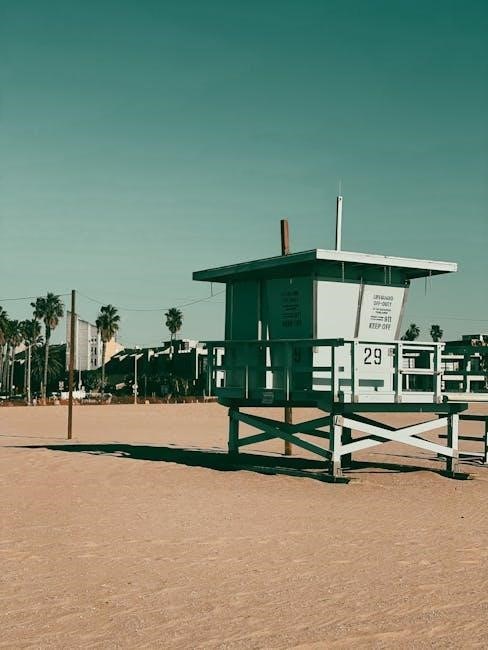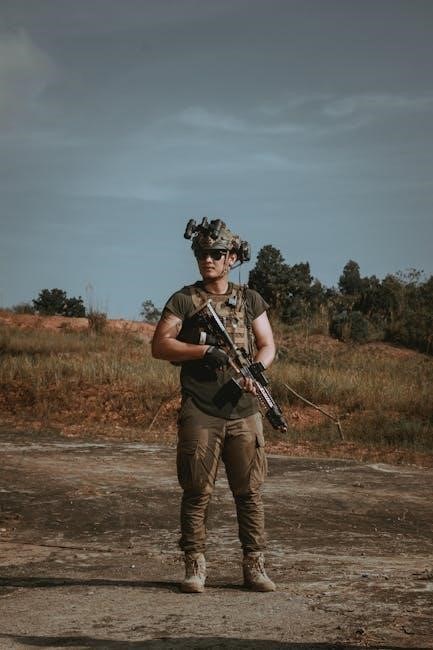Welcome to the Paw Patrol Casting Station, a comprehensive guide to creating your own 3D Paw Patrol figures. This fun, creative activity lets kids craft and customize their favorite pups using plaster, molds, and paint, providing hours of engaging entertainment and fostering imaginative play.
1.1 Overview of the Casting Station
The Paw Patrol Casting Station is an all-inclusive arts and crafts kit designed for kids to create their own 3D Paw Patrol figures. It features silicone molds of popular characters like Chase and Skye, along with plaster, paint, and brushes. The kit provides everything needed to mold and customize figures, encouraging creativity and imaginative play. With easy-to-follow instructions, children can mix plaster, fill molds, and paint their characters, resulting in unique, personalized Paw Patrol pups. Suitable for children aged 5 and above, this kit offers a fun and educational experience, combining crafting with a love for the Paw Patrol series.

1.2 Importance of Following Instructions
Following the instructions provided with the Paw Patrol Casting Station is essential for a successful and safe crafting experience. Properly mixing the plaster, preparing the molds, and painting requires attention to detail to achieve the best results. Skipping steps or ignoring guidelines can lead to issues like uneven casts or damaged molds. Adult supervision is recommended, especially for younger children, to ensure safety and help with complex tasks. By adhering to the instructions, kids can avoid common mistakes and enjoy a fun, creative process. This structured approach also teaches valuable skills like patience and precision, making the experience both enjoyable and educational.

Materials and Tools Required

The Paw Patrol Casting Station includes plaster, silicone molds of characters like Chase and Skye, various paints, and brushes for a fun, complete creative experience with everything needed.
2.1 Included Items in the Kit
The Paw Patrol Casting Station kit comes with essential materials to get started. It includes bags of plaster for creating molds, two silicone molds featuring popular characters like Chase and Skye, six vibrant paints, a paintbrush for detailing, and a comprehensive instruction manual. These components provide everything needed to craft and customize your own 3D Paw Patrol figures. The kit is designed to be user-friendly, ensuring a smooth and enjoyable experience for kids and adults alike. With these items, you can easily mold, paint, and bring your favorite Paw Patrol characters to life in just a few steps.
2.2 Additional Tools Needed for Assembly
While the Paw Patrol Casting Station kit includes most necessary items, a few additional tools are recommended for a seamless assembly process. A mixing bowl and spoon are essential for preparing the plaster mixture. A clean, flat workspace, such as a table or countertop, is ideal for casting and painting. Optional tools like a small measuring cup can help in accurately measuring water for the plaster. Adult supervision is advised, especially when handling materials like plaster, to ensure safety and proper technique. Having these tools on hand will enhance the overall experience and make the assembly process more efficient.

Step-by-Step Casting Instructions
Prepare your workspace, mix the plaster, pour into molds, and let it dry. Paint your figures and enjoy your custom Paw Patrol creations!
3.1 Preparing the Workspace
Begin by setting up a clean, stable workspace. Cover your table or countertop with paper or a cloth to protect it from plaster and paint spills. Gather all materials, including molds, plaster, paint, and brushes, and organize them within easy reach. Ensure good ventilation to avoid inhaling plaster dust. Put on protective gloves and goggles for safety. Place the casting station in the center of your workspace for easy access. Before starting, review the instructions in the provided PDF to familiarize yourself with the process. Encourage children to stay organized and follow each step carefully for a smooth experience.
3.2 Mixing the Plaster
Start by carefully opening one bag of plaster and pouring it into a clean, dry container. Gradually add cold water while stirring with a spoon or stirrer to avoid lumps. Follow the ratio specified in the instructions to ensure the mixture is smooth and pourable. Stir thoroughly for about 30 seconds until the plaster reaches a thick, even consistency. Avoid overmixing, as it can create air bubbles. Once mixed, immediately pour the plaster into the prepared silicone molds, filling them to the top. Use a spatula to remove excess and ensure a flat surface. Allow the plaster to set before proceeding to the next step.
3.3 Using the Silicone Molds
Before pouring the plaster mixture, ensure the silicone molds are clean and dry. Gently place the molds on a flat surface to maintain even casting. Pour the mixed plaster into each mold, filling it to the top. Use a spatula or similar tool to remove any excess plaster and smooth the surface. Avoid creating air bubbles by tapping the mold gently on the table. Allow the plaster to set completely, following the recommended drying time in the instructions. Once set, carefully flex the silicone molds to release the cast figures. Repeat the process for additional characters using the included molds.
3.4 Painting the Figures
Once the plaster figures are dry, it’s time to bring them to life with paint. Gather the included paints, brush, and the instruction guide for reference. Begin by painting the larger areas first, such as the body and uniform, using the corresponding colors. Add finer details like eyes, badges, and accessories last. Follow the guide for accuracy or get creative with unique designs. Allow each coat of paint to dry completely before applying additional layers. For a glossy finish, consider applying a clear sealant. Adult supervision is recommended for younger children. Let the paint dry fully before handling the figures to ensure durability and longevity.
3.5 Allowing the Plaster to Dry
After pouring the plaster mixture into the molds, patience is key. Allow the plaster to dry completely, which typically takes 20–30 minutes, depending on the mold size and environmental conditions. Ensure the figures are undisturbed during this time to prevent misshaping. Once dry, they should feel hard and lightweight. Avoid touching the figures until fully set, as moisture or pressure could damage the plaster. Keep the molds away from direct sunlight or moisture to prevent warping or sticking. Once dry, carefully remove the figures from the molds and prepare for painting. Proper drying ensures durable, long-lasting results.

Troubleshooting Common Issues
Address common casting challenges like uneven plaster mixing or mold sticking by adjusting ratios, using release agents, and ensuring proper drying times for smooth results.
4.1 Common Problems During Casting
Common issues during casting include uneven plaster mixing, mold sticking, or incomplete drying. Air bubbles may form, causing surface imperfections. Plaster might set too quickly or not harden properly. Molds can become misaligned, leading to distorted figures. Paint may peel or fade if applied incorrectly. To avoid these, ensure proper mixing ratios, use a release agent, and allow adequate drying time. Leveling the workspace and gentle demolding can prevent sticking and misalignment. Following the instructions carefully helps minimize these issues and ensures successful casting results.
4.2 Solutions for Plaster and Mold Issues
For plaster issues, ensure proper mixing ratios and avoid over-stirring. If plaster sets too quickly, mix smaller batches. For mold sticking, lightly spray a release agent or dust with powder. To prevent air bubbles, tap molds gently before pouring. If figures stick, let them dry completely before demolding; For paint peeling, ensure plaster is fully dry and use thin, even coats. Regularly clean molds with mild soap and water to maintain their condition. Proper storage of molds in a dry place prevents deformation. Following these tips ensures smooth casting and durable, high-quality Paw Patrol figures.

Safety Precautions
Always follow safety guidelines when using the Paw Patrol Casting Station. Ensure adult supervision for children, wear protective gloves, and work in a well-ventilated area. Avoid ingesting materials and keep them out of reach of young children. Follow instructions carefully to prevent accidents and ensure a safe, enjoyable experience.
5.1 General Safety Tips
When using the Paw Patrol Casting Station, ensure a safe and enjoyable experience by following these general safety tips. Always supervise children during the process, as some materials may pose choking hazards or cause skin irritation. Wear protective gloves and work in a well-ventilated area to avoid inhaling plaster dust. Keep all materials out of reach of younger siblings and pets. Avoid ingesting any substances, including plaster or paint. Ensure the workspace is clean and stable to prevent accidents. Follow the instructions carefully and take regular breaks to maintain focus. By adhering to these guidelines, you can create a fun and safe environment for crafting your favorite Paw Patrol figures.
5.2 Importance of Adult Supervision
Adult supervision is crucial when using the Paw Patrol Casting Station to ensure safety and success. While the kit is designed for children, certain steps, like mixing plaster or handling molds, require adult guidance to prevent accidents. An adult can help manage potentially messy materials, prevent ingestion of substances, and assist with complex tasks. Their involvement also enhances the learning experience, teaching children proper techniques and safety practices. Additionally, adult supervision helps maintain a structured and enjoyable activity, fostering creativity while keeping the process safe and organized. Always encourage collaborative effort between children and adults for the best results.

Creative Tips for Customization
Unleash creativity by using alternative materials like glitter or stickers for unique figure designs. Experiment with paint colors and add personalized details to make each Paw Patrol character one-of-a-kind.
6.1 Adding Personalized Details
Personalizing your Paw Patrol figures adds a unique touch to each character. Use paint to create vibrant patterns or mix colors for exclusive shades. Add stickers, glitter, or small decals for extra flair. Consider adding accessories like tiny badges or custom symbols to make each figure stand out. For a more realistic look, use fine brushes to paint on details like eyes or textures. You can also experiment with layering paint for depth or applying a clear coat to protect your designs. These personal touches allow kids to express their creativity and make their Paw Patrol figures truly one-of-a-kind.
6.2 Using Alternative Materials
Exploring alternative materials can enhance your Paw Patrol casting experience. Instead of plaster, try using air-dry clay or resin for different textures. Experiment with fabric paint for a softer look or metallic paint for a shiny finish. Adding glow-in-the-dark paint can create unique effects. You can also incorporate recycled materials, like glitter or small beads, into the plaster mix for added sparkle. For a more durable figure, apply a clear varnish after painting. These creative substitutions allow for endless possibilities, making each Paw Patrol figure truly unique and personalized to your style.
Accessing the Instructions PDF
Visit the official website or trusted platforms to download the Paw Patrol Casting Station instructions PDF, ensuring easy access to comprehensive guides for your creative project.
7.1 Finding the Instruction Manual Online
To locate the Paw Patrol Casting Station instructions PDF, visit official manufacturer websites or trusted platforms like ManualsLib. Use search terms such as “Paw Patrol Casting Station instructions PDF” to find relevant documents; Ensure to verify the source for authenticity to avoid downloading unofficial guides. Additionally, check the manufacturer’s support page, where you can search by product name or model number. Some platforms allow filtering by document type, ensuring you find the correct manual efficiently. Always review the PDF to confirm it matches your specific kit before proceeding with your project for the best results.
7.2 Navigating the PDF Document
Once you’ve downloaded the Paw Patrol Casting Station instructions PDF, navigate through the document using bookmarks or the table of contents. The PDF typically includes sections like materials required, step-by-step casting instructions, and safety tips. Use the search function to quickly find specific keywords, such as “mixing plaster” or “painting figures.” Zoom in on detailed diagrams for clarity and refer to troubleshooting guides if issues arise. Ensure to review all safety precautions before starting. The document is designed to be user-friendly, with clear headings and visuals to guide you through the process. Print specific pages if needed for easy reference during your project.

Storage and Maintenance
Store the Paw Patrol Casting Station in a dry, clean environment. Clean molds and tools with mild soap and water after use. Avoid leaving mixed plaster in molds. Keep paints sealed tightly to prevent drying out. Regularly inspect and maintain all components for optimal performance. Proper storage ensures longevity and readiness for future creative sessions.
8.1 Proper Storage of the Kit
Store the Paw Patrol Casting Station in a dry, clean environment to maintain its quality. Avoid exposing it to humidity, as this can cause the plaster to clump. After use, ensure all components, including molds and tools, are thoroughly cleaned with mild soap and water. Paints should be tightly sealed to prevent drying out. Place the kit in its original packaging or a sturdy container to protect it from dust and damage. Keep it out of reach of younger children to avoid accidental damage; Proper storage ensures the kit remains in excellent condition for future creative sessions and keeps everything organized and ready for use.
8.2 Maintaining the Molds and Tools
Regularly clean and maintain the molds and tools included in the Paw Patrol Casting Station to ensure optimal performance. After each use, wash molds with mild soap and warm water to remove any residual plaster or paint. Avoid using abrasive materials that could scratch the silicone molds. Tools like brushes and mixing utensils should also be cleaned thoroughly. Allow all items to air dry completely before storing them to prevent moisture buildup. Occasional application of a light oil to metal tools can prevent rust. Proper maintenance extends the lifespan of the kit, ensuring molds remain flexible and tools stay functional for future projects.

Additional Resources
Explore additional resources, including manufacturer guides, online communities, and YouTube tutorials, to enhance your Paw Patrol Casting Station experience. Find troubleshooting tips, creative ideas, and detailed instructions online for continuous learning and fun.
9.1 Manufacturer Support and Guides
The manufacturer provides extensive support for the Paw Patrol Casting Station, including downloadable PDF guides and detailed instructions. These resources are available on the official website and cover topics like troubleshooting, material usage, and safety tips. Additionally, customer support is accessible for any queries or issues, ensuring a smooth experience. The guides are regularly updated to address common concerns and provide clarity on complex steps. By utilizing these resources, users can maximize their kit’s potential and enjoy a hassle-free creative journey with their favorite Paw Patrol characters. This support ensures that both kids and adults can confidently navigate the casting process.
9.2 Online Communities and Tutorials
Online communities and tutorials offer additional support for mastering the Paw Patrol Casting Station. Forums, social media groups, and YouTube channels dedicated to arts and crafts often feature user-generated guides and tips. These platforms provide creative ideas, troubleshooting advice, and step-by-step tutorials to enhance your casting experience. Many enthusiasts share their projects, inspiring others to experiment with custom designs. Additionally, websites like Pinterest and Instagram showcase finished projects, offering visual inspiration for painting and customizing figures. While these resources are helpful, always refer to the official instructions for safety and accuracy. Online communities are a great way to connect with fellow creators and learn new techniques to make the most of your kit.
With the Paw Patrol Casting Station, you’ve completed a fun, hands-on creative journey. Now, let your imagination shine and start crafting your favorite Paw Patrol figures today!
10.1 Final Thoughts on the Project
The Paw Patrol Casting Station project is a rewarding and engaging activity that sparks creativity and patience. By following the step-by-step instructions, kids can successfully create their own 3D Paw Patrol figures, fostering a sense of accomplishment. The process of mixing plaster, using molds, and painting allows children to develop fine motor skills and attention to detail. This project is not only fun but also educational, teaching kids the basics of crafting and the importance of following directions. The end result is a personalized keepsake that brings joy and pride, making it a memorable experience for young Paw Patrol fans.
10.2 Encouragement to Start Creating
Embark on this exciting journey with the Paw Patrol Casting Station! With its straightforward instructions and inclusive kit, creating your own 3D figures is easier than ever. Dive into the world of Chase, Skye, and Marshall, bringing their adventures to life through plaster, paint, and creativity. This project is perfect for kids and adults alike, offering a fun way to bond and express artistic flair. Don’t hesitate—gather your materials, follow the steps, and watch your favorite pups take shape. Every mix, mold, and brushstroke is a step toward a unique, personalized keepsake. Start creating today and unlock hours of imaginative fun and lasting memories!